Submarine cables are the backbone of the global communication system today.
Over 400 cables run across the oceans and create a robust network that connects almost every part of the world. The submarine cable network is responsible for transmitting 99% of the world’s data.
It is a more reliable and speedy medium than satellite communication.
Our wireless connectivity, Wifi, 3G, 4G, at homes and offices, is nearly impossible without the existence of a submarine cable. It not only connects us between countries, but it also allows communication between two cellular towers.
So, in a nutshell, without a submarine cable, communication seems impossible.
Pakistan Telecommunication Company Limited (PTCL) has a clear edge over rivals in Pakistan for managing the submarine cables that connect it to the world.
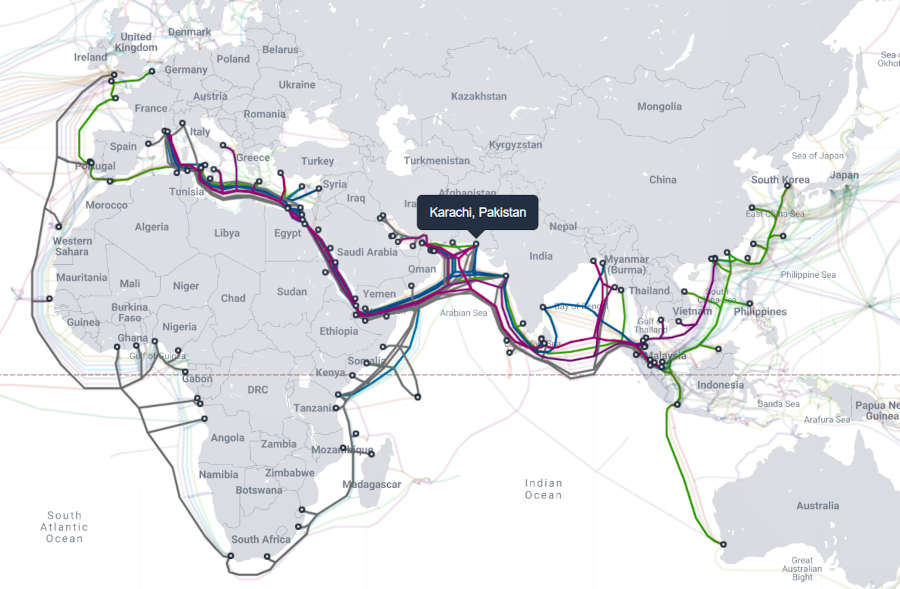
Out of six active cables connecting Pakistan with the world, PTCL is the co-owner of four and is entitled to over 80Tbs bandwidth capacity it delivers to the country.
We will tell you in this article everything important about a submarine cable and what is PTCL’s role in keeping Pakistan connected with the rest of the world.
- What is a submarine cable?
- How does submarine cable work?
- Who owns submarine cables?
- How are undersea cables laid out?
- Myths about submarine cable cuts in Pakistan
- What happens when a submarine cable gets cut?
- What is the process of cable repair?
- How much does submarine cable cost?
- Life of a submarine internet cable
What is a submarine cable?
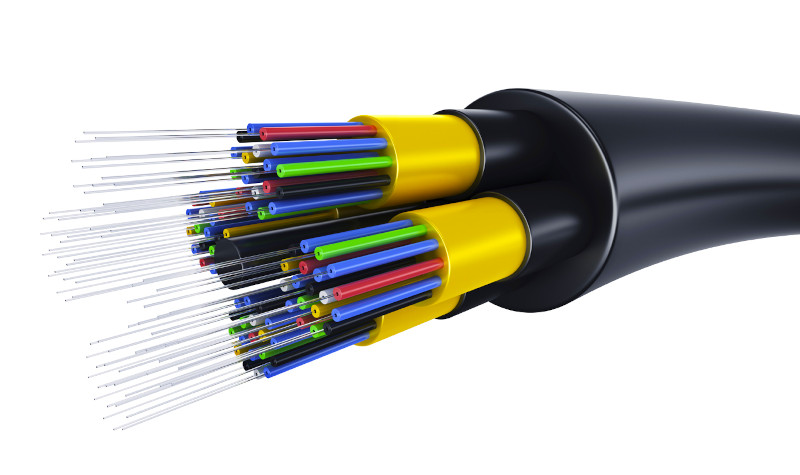
Sometimes we call it an undersea cable, deep-sea cable, or an optic fiber cable, all referring to a submarine cable that carries fiber as a medium for transmitting precious data inside the ocean.
An optic fiber cable on the ground isn’t much wider than a garden hose. Under the sea, its survival is only possible by applying several layers of protection around it to save it from wandering ships, weather and natural calamities.
These multiple layers make the cable much more expansive and hefty.
The middle of the cable carries pair of fiber glass threads for transmitting the information. Silicone gel wraps around the fibers, and then several layers of plastic, steel, copper, polythene insulator and nylon protect it.
The cable also encloses a number of repeaters across its length – each positioned after roughly 60 miles. Their task is to amplify signals so they don’t lose strength while traveling between countries and continents.
How does submarine cable work?
Data is fired at extremely high speed in the form of laser down thin glass fibers, and receptors at the other end receive and decode the data.
One fiber is as thin as a strand of human hair wrapped by several protective layers, as described earlier.
So primarily, a cable transfer data from one end to the other at a blazing fast speed.
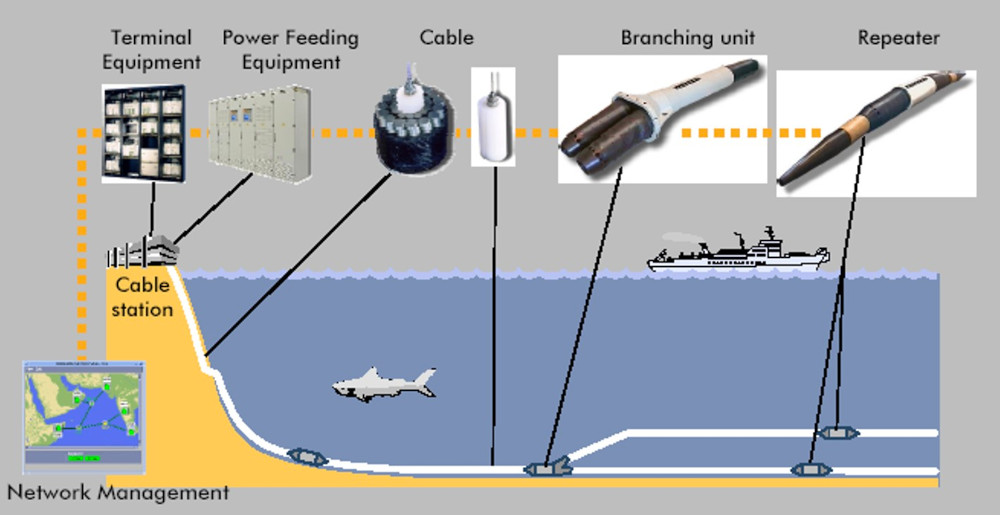
In its simplest form, an undersea cable between two countries can have two landing stations – one in each country. For example, the shortest submarine cable Pakistan connects with is Transworld (TW1) which has three landing stations – Pakistan, Oman and UAE.
A landing station or a cable station is where a submarine cable connects with two types of equipment, a Terminal Equipment, and Power Feeding Equipment. We call it a gateway.
The power feeding equipment ensures a consistent power supply to repeaters inside the cable to keep it alive 24/7. For example, the SMW-3 submarine cable, one of the planet’s largest cables, covers a 39,000 km area and runs 800 volts of current.
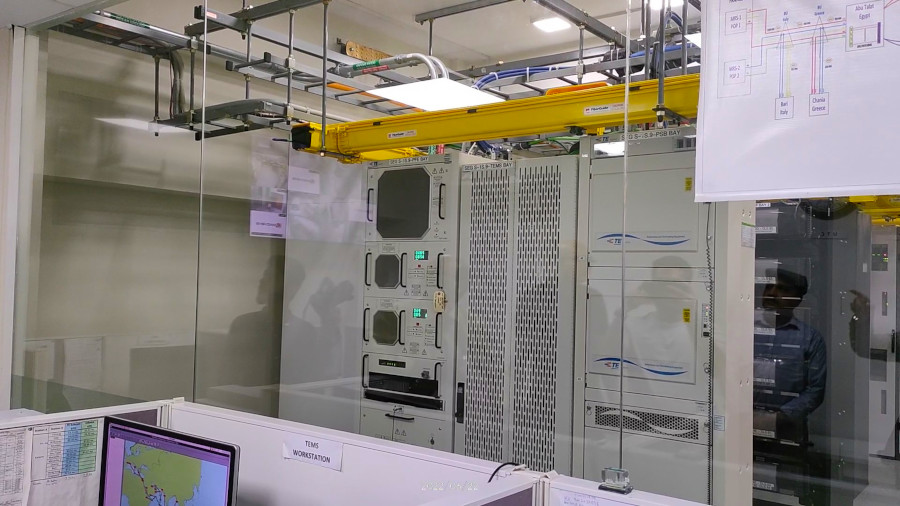
However, on both ends, the terminal equipment takes care of the data that moves through the submarine cable. High-capacity routers on the landing station connect with a series of routers and data centers throughout the country to take the data to end-users.
In contrast, longer cables like SMW-4 cross through continents to connect a number of countries on their way from one end to the other. This undersea cable lands at 16 destinations. Each country has a landing station that connects the trunk (primary cable) with the branch cables.
Who owns submarine cables?
The consortium of telecom operators owned submarine cables between different countries. But more recently, private companies such as Google, Facebook, and Amazon have joined the mix to lay out cables.
Over the years, the demand for their content has risen exponentially, which led them to plan out their own cables.
They also offer the bandwidth to other operators as a part of their business model.
Both models exist and work side by side. For example, the 25,000 km long AAE-1 submarine cable connects 19 countries, and a consortium of 19 telecom operators owns it.
Each consortium member pools funds and is responsible for lighting up and managing the entitled submarine length.
in the case of AAE-1, the consortium includes China Unicom, Djibouti Telecom, Etisalat UAE, Hyalroute, Metfone, Mobily, National Telecom, OTEGLOBE, Omantel, Ooredoo, PCCW, Pakistan Telecommunications Company Ltd., Reliance Jio Infocomm, Retelit, TIME dotCom, TeleYemen, Telecom Egypt, VNPT International, and Viettel Corporation.
How are undersea cables laid out?
Laying out a submarine cable is a huge undertaking.
The consortium (or an individual entity), after initial working, tasks a vendor to survey the desired area along the proposed route to identify a suitable roadmap for the undersea cable.
Vendor’s ships usually comprise all necessary equipment and an over 80 people technical team. They take 3 to 4 months to survey the intended route. It also includes the soil analysis.
After meeting all requirements, the ship acquires the cable directly from the manufacturer and rolls it out along the path. A typical vendor ship can load 5000 to 7000 km cable on board.
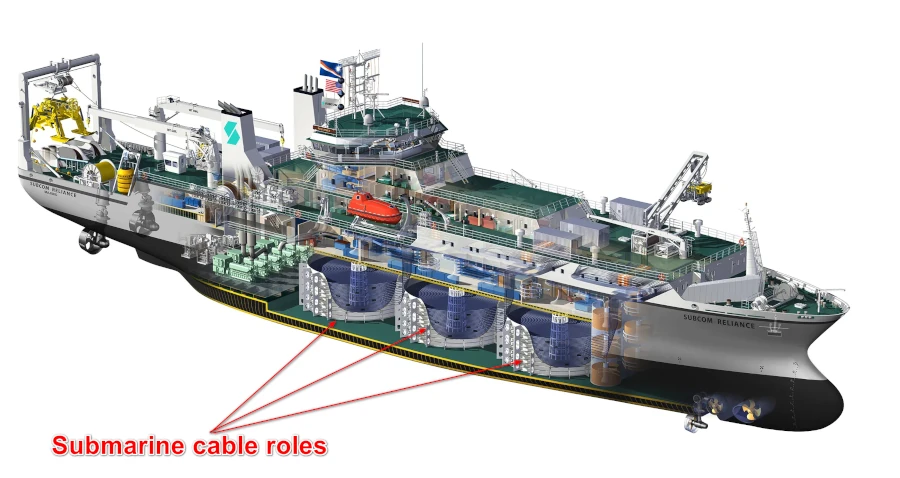
The cable lies freely on the seabed, but near shores, the practice is to bury it 1.5 meters in the ground which is why we don’t see the cable coming out of the sea.
Of course, at the time of the survey, the emphasis is to choose an area for the cable that remains less busy to ensure the safest path and avoid fault zones, anchoring zones, fishing areas and other dangers.
Myths about submarine cable cuts in Pakistan
A common myth about submarine cable cuts is that sea wildlife, mostly sharks, is responsible for the damage.
The blame is based on a viral video that shows a shark biting the cable and moving away.
Tariq Obedullah Balghari, SM Intn’l Operation Support PTCL, calls it a bluff.
“I have never heard a shark bite caused a cable cut in the past 20 years,” he explains.
A submarine cable is more vulnerable when it comes out of the deep sea near the landing station.
“Although we make sure to hide it 1.5 meters underground up to 1 kilometer from the shore, it is still exposed to ship anchors and deep-sea fishing.”
Ship anchoring mostly happens within 800 to 2000 meters from the beach, which is always a risk.
A submarine cable can come across three types of damage:
- Cable cut
- Power supply damage
- Or both
What happens when a submarine cable gets cut?
When a cable gets damaged in the territorial waters due to any of the reasons we mentioned earlier, the internet goes off for a particular segment of users whose data transmission relies on that specific cable.
A telecom operator with a single cable in the sea will find it hard to keep serving its customers until the fault is fixed, which may sometimes take months.
It’s easier for a company with multiple undersea cables to shift the affected bandwidth to its other active cable after a minor internet disruption.
This way, internet traffic keeps flowing for a country but does not entirely stop. It may get slower due to congestion of bandwidth, though.
Think of a road that gets blocked due to a calamity, and the authorities shift the traffic to an alternate route that might cause everyone (existing and new traffic) to move slowly.
It all depends upon the capacity of an alternate route. Nothing will slow down if it is bigger enough to tackle the entire traffic. It is the bandwidth in the case of a submarine cable.
The following table shows the number of active submarine cables in Pakistan and their capacities.
Existing submarine cables in Pakistan
| Cable Name | Capacity | Length (km) | Landing Party |
| SMW-3 | 15Gps | 39,000 | PTCL |
| SMW-4 | 16Tbps | 20,000 | PTCL |
| SMW-5 | 24Tbps | 20,000 | Transworld |
| AAE-1 | 40Tbps | 25,000 | PTCL |
| IMEWE | 24Tbps | 12,000 | PTCL |
| TW1 | 1.28Tbps | 1,300 | TransWorld |
| PEACE | 96Tbps | 21,500 | Cybernet |
Upcoming submarine cables in Pakistan
| Cable Name | Starting Year | Length (km) | Landing Party |
| 2Africa | 2023 | 45,000 | China Mobile |
| Africa-1 | 2023 | 10,000 | PTCL |
| SMW-6 | 2025 | 19,200 | TransWorld |
What is the process of cable repair?
For being an armored cable, it is not easy to cut it, but it isn’t easy to repair an undersea cable either.
When a fault occurs, the concerned telecom operator takes a series of steps.
- It usually takes two days to detect the fault. Once detected, the telco contacts the contractor to fix it.
- In the case of PTCL, it informs UAE-based E-marine, a contractor and a subsidiary of Etisalat.
- They dispatch a ship to the affected destination (Pakitan in this case) to acquire approvals for nearly 100 crew members on board.
- The ship moves only when PTCL obtains clearance for the crew members from multiple government departments, including the ministry of defense in Pakistan. It’s a time taking process and sometimes takes weeks.
- After getting approval, PTCL asks the ship to move, which is a 4-day journey from UAE. When it reaches Karachi, PTCL and security agencies officials get on board and move to the faulty area.
- Later, the repair process needs around 5 days.
- After fixing the fault, the ship returns to the landing station (Karachi in this case), gets the paperwork done, and travels back to its base port.
Per industry standards, the ideal duration to fix a fault is 1.5 months.
According to Mr. Balghari, PTCL repaired the AAE-1 fault in December 2021 in 1.5 months, whereas Indians took 3.5 months to fix SMW-4 in April 2022 near Bombay due to slow departmental approvals.
Here is a list of recent faults in the Submarine cables within Pakistan’s territory.
- Oct 2019 – PTCL cable fault and internet disruption
- Mar 2020 – SMW-5 fault
- May 2020 – PTCL cable fault (Shark Memes)
- Feb 2021 – SMW-5 (TWA)
- Dec 2021 – PTCL cable cut (AAE-1)
- Jan 2022 – SMW-4
- Feb 2022 – TW1
- Apr 2022 – SMW-4
- June 2022 – AAE-1 + SMW-5 (cable cut)
As far as the on-site repair process is concerned, the E-Marine crew lifts the faulty cable through specialized equipment that lies deeper on the sea bed. They attach a piece of fresh cable and join it on both ends. However, the process isn’t as simple as it looks.
Continous repair weakens cable’s capacity; therefore, we never hope to come across cable damage incidents, Mr. Balghari asserted.
Mr. Balghari further said that one repair costs around $0.8 million to $1 million.
“And the fact that repair work weakens the original strength of the cable, and it’s a huge cost to fix it every time a fault occurs, we try to avoid both.”
Watch the video below that explains the actual repair work of the submarine cable.
How much does submarine cable cost?
It’s a costly project and depends on how many parties pool funds in a consortium and the length of the cable. For a single entity, it’s a huge investment.
For example, 25,000 km long AAE-1 cost around $800 million, leaving us to guess a $40 – $50 million share per operator.
Life of a submarine internet cable
Going by the book, the life of a submarine cable is 25 years. It has to be decommissioned after that limit.
SMW-3 expires in 2023, when PTCL will decommission it.
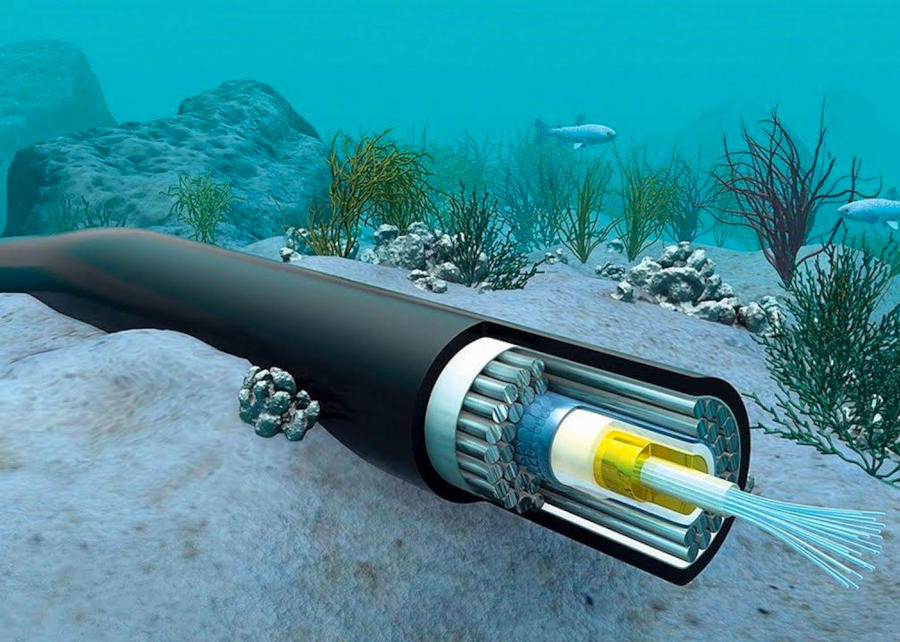
I really never watched, read or even hear such a great article in my entire life… Its a real noble piece of precious information….
Love you sir….
Became your biggest fan……
Excellent Mudassar!